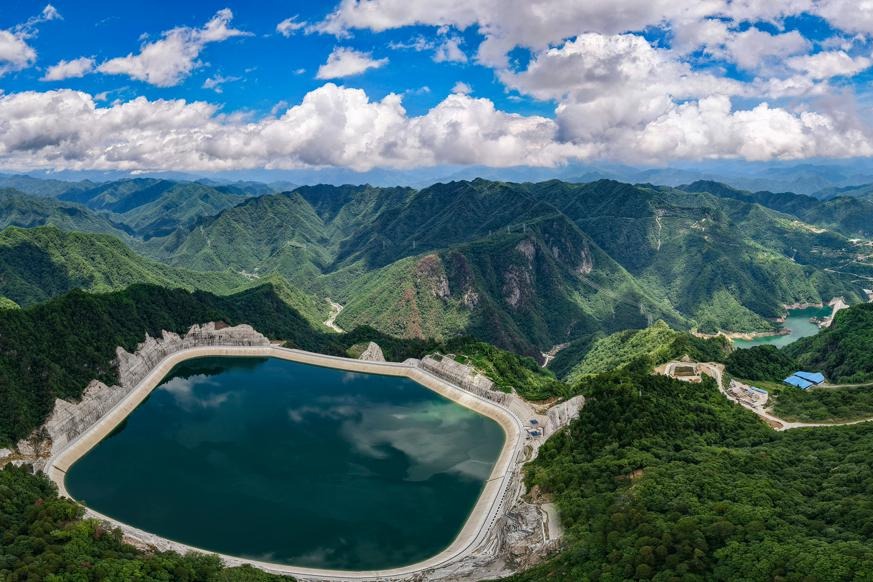Researchers help save Qilian's ecosystem
Monitoring and study of diverse factors go on in tough terrain


The Qinghai spruce, a keystone species of the Qilian Mountains ecosystem, thrives in the remote northwestern interior of China. These trees have straight trunks and reach about 20 meters in height at maturity, a process that takes around 100 years. Year-round, these spruces bear silent witness to the changes in the local ecosystem and landscape.
In the midst of these verdant forests, Jing Wenmao, director of the Xishui forest ecology research station under the Gansu Province Academy of Qilian Water Resource Conservation Forests Research Institute, and his team have installed specialized equipment to conduct comprehensive "health checks" on the coniferous trees.
"According to national standards, we conduct systematic surveys of the arboreal forests every five years, measuring height, crown width, trunk diameter, and root systems," Jing said. "We have 16 arboreal sample plots, alongside nine herbaceous and 12 shrub plots, covering various elevations and forest types. Our long-term monitoring helps us understand which ecological environments best support these plants."
It takes about a month and a half for Jing's team to monitor all the sample plots. "Shrubs grow in high-altitude areas inaccessible by car, requiring strenuous hikes," he said. "Thus our work is physically demanding."
Beyond the quinquennial tree surveys, Jing and his team also conduct monthly, and sometimes daily, observations of other ecological factors in the Qilian Mountains. "From trees to flowers and grasses, we track their entire growth cycle — sprouting, leafing, flowering, seed dispersal, and wilting," he said.
Their ecological research also involves regular manual observations of meteorological elements, maintenance of weather equipment, and periodic soil sampling to assess changes in physical and chemical properties, as well as water quality monitoring.
"During busy periods, team members may not return home for a month or two," said Bai Xue, deputy director of the forestry and grassland bureau of Zhangye city in Gansu.
Yet, Jing still thinks that the monitoring and research on forest ecology are both worthwhile and essential. "The Qilian Mountains, straddling the transition from the Qinghai-Tibet Plateau to the Hexi Corridor, boast characteristics of both high plateau and desert transition zones. With elevations ranging from 2,000 to 5,000 meters, the diverse vegetation types and micro-landforms create a complex and layered ecosystem, crucial for studies on climate change and ecological protection," Jing said.
The Qilian Mountains also play a vital role in water conservation, with abundant precipitation and glacial melt feeding the Shiyang, Shule and Heihe river systems, sustaining over 440 million people in the downstream communities of the Hexi Corridor. Ensuring the continuous flow of these water systems is of utmost importance.
In 1978, China established its first research institute dedicated to water conservation — the Gansu Province Academy of Qilian Water Resource Conservation Forests Research Institute in the Zhangye section of the Qilian Mountains. This institute was founded by a group of young graduates from universities in Beijing, Gansu and Shaanxi provinces, who were driven by a fervent desire to serve their country. They left the bustling cities behind and ventured into the remote, uninhabited natural forests of the Qilian Mountains. With sheer determination, they set up sample plots and observation sites from scratch and began hydrological research on the watersheds.
"The previous three generations of researchers laid the groundwork here, and as the new generation, we are essentially standing on the shoulders of giants," said Jing Wenmao, reflecting on the significant achievements of his predecessors.
Like the Qinghai spruces, generations of researchers have rooted themselves in the Qilian Mountains, persevering through harsh natural conditions, and enduring poverty and isolation. They have conducted long-term ecological monitoring and fundamental research in forest hydrology, soil, meteorology, and biodiversity.
In 1989, the institute's researchers completed a pioneering study on the mechanism of forest water conservation, which systematically explained how forest water is conserved for the first time in China.
Jing joined the institute in 2001, fresh out of university. "I studied forestry in college and imagined that the institute would be engaged in high-level scientific research. With this ideal in mind, I came here," he said.
However, the reality of the institute was shocking.
"The conditions in the mountains were extremely poor. Researchers lived in mud huts, fetched water from rivers, had unstable electricity, and no mobile signal. For the first 10 years, my only source of external information was a TV with a satellite receiver, which could only receive five channels," he said.
"I spent my days in technical observations, writing research reports, and papers. The monitoring was entirely manual, requiring us to climb high altitudes daily with notebooks. We didn't even have cameras; we just kept recording and writing, then organized the data afterward."




































